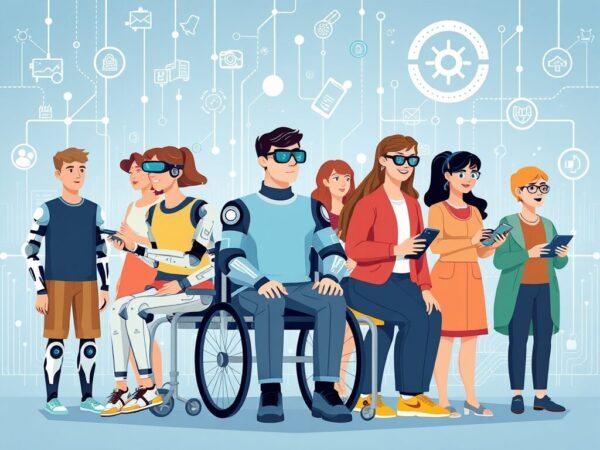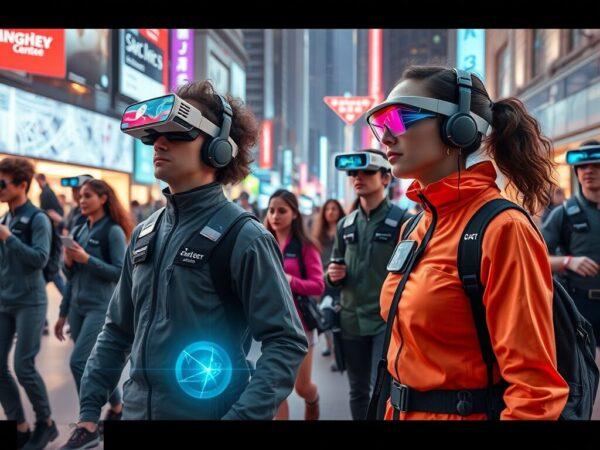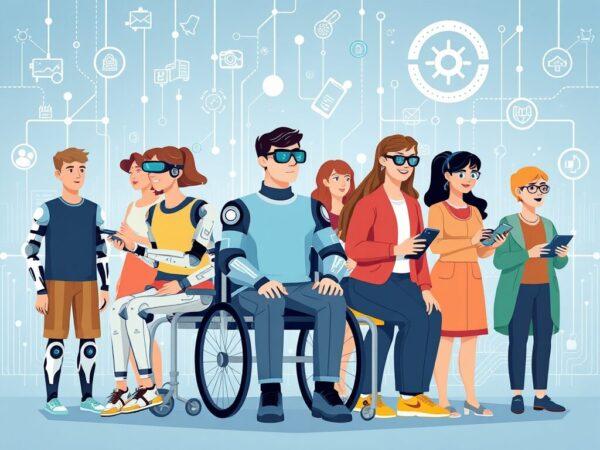
Artificial Intelligence in Disabilities: Pioneering a New Era of Inclusivity
Artificial Intelligence in Disabilities, Historically, Role of Artificial Intelligence in Disabilities, 2025. Individuals with disabilities have faced significant barriers – physical, communicative, cognitive, and social – that have limited their participation and independence.
I. How Does AI Help with Disabilities? Unlocking Potential and Fostering Independence
1. Personalization and Adaptive Support: One of the most significant contributions of AI is its capacity for personalization. Traditional assistive technologies, while helpful, often offer a static solution. AI, conversely, can learn from an individual’s unique preferences, habits, learning styles, and specific challenges, then adapt its functionality in real-time.
- Tailored Learning Paths: For individuals with learning disabilities, cognitive impairments, or developmental disorders like Attention-Deficit/Hyperactivity Disorder (ADHD) or dyslexia, AI-powered educational platforms can dynamically adjust content difficulty, presentation format (e.g., text size, color contrast), pace of instruction, and feedback mechanisms.
- Adaptive Physical Support: In the realm of physical disabilities, AI is revolutionizing assistive devices. Smart wheelchairs equipped with computer vision and navigation algorithms can autonomously detect obstacles, map accessible routes, and adjust their movement parameters based on terrain or user input, offering a level of independent mobility previously unattainable. Similarly, intelligent prosthetic limbs integrate sensors and AI algorithms that learn a user’s unique gait, muscle signals, and movement intentions. This allows the prosthetic to respond more naturally and fluidly, mimicking biological movements and significantly improving stability, energy efficiency, and user comfort. Exoskeletons, powered by AI, can augment strength and mobility for individuals with paralysis or severe weakness, learning to anticipate and support their desired movements through biofeedback.
- https://www.youtube.com/watch?v=yTK6N2H1NFQ
2. Enhanced Communication and Linguistic Accessibility: Communication barriers are among the most isolating challenges faced by individuals with various disabilities. AI is breaking down these barriers through sophisticated language processing and recognition technologies.
- Advanced Speech-to-Text and Text-to-Speech (TTS): AI-powered speech recognition systems have achieved remarkable accuracy, converting spoken language into written text in real-time. This is transformative for individuals who are deaf or hard of hearing, providing immediate captions for conversations, lectures, or media content (e.g., Google’s Live Transcribe). For individuals with motor impairments that affect typing or writing, speech-to-text enables effortless communication and content creation. Conversely, AI-driven text-to-speech engines produce highly natural-sounding synthetic voices, allowing individuals with speech impediments or mutism to communicate effectively. These systems can even be personalized to generate voices that sound closer to the user’s original voice or a preferred voice, enhancing authenticity and comfort.
- Augmentative and Alternative Communication (AAC) Systems: AI significantly enhances AAC devices. Predictive text algorithms, powered by natural language processing (NLP) and machine learning, anticipate words and phrases based on context and previous usage, dramatically speeding up communication for users who rely on typing or symbol selection. Some AI-driven AAC systems are even being developed to interpret subtle non-verbal cues, such as eye movements, facial expressions, or brain signals, to infer communication intent for individuals with severe paralysis or locked-in syndrome, converting these into spoken or written output.
- Sign Language Recognition and Translation: This is a rapidly evolving area where AI is making significant strides. Computer vision models trained on vast datasets of sign language gestures, facial expressions, and body movements can recognize and interpret sign language in real-time, translating it into spoken or written language. Conversely, AI can generate animations or text that translate spoken language into sign language, bridging communication gaps between the Deaf community and the hearing world. Such technologies hold immense promise for inclusive interactions in public spaces, educational settings, and professional environments.
3. Cognitive and Mental Health Support: AI is proving to be an invaluable asset in supporting individuals with cognitive disabilities, neurodevelopmental disorders, and mental health conditions often co-occurring with disabilities.
- Cognitive Augmentation: For individuals with memory impairments (e.g., due to traumatic brain injury, dementia, or learning disabilities affecting executive function), AI can serve as a powerful cognitive assistant. These tools reduce cognitive load, promote independence, and enhance daily functioning.
- Emotional and Behavioral Regulation: AI-powered applications, often integrated into wearable devices or smart environments, can monitor physiological indicators (e.g., heart rate, skin conductance) and behavioral patterns to detect early signs of stress, anxiety, or emotional dysregulation. They can then offer personalized interventions, such as guided breathing exercises, calming sounds, or prompts to engage in pre-defined coping strategies. For individuals with Autism Spectrum Disorder (ASD), AI can help in social skill development through interactive simulations and provide real-time feedback on social cues.
- Mental Health Support and Early Intervention: AI-driven chatbots and virtual companions are emerging as a form of accessible mental health support. While not replacing human therapists, they can provide initial screenings, offer psychoeducation, guide users through therapeutic exercises (like cognitive behavioral therapy techniques), and provide a non-judgmental space for expression. They can also identify distress signals and, if necessary, recommend seeking professional help. This is particularly beneficial for individuals who may face barriers to accessing traditional mental health services.
4. Enhanced Sensory Perception and Navigation: AI significantly augments existing senses and provides alternative ways to perceive the world for individuals with sensory impairments.

- For Visual Impairments (Blindness and Low Vision):
- Object and Scene Recognition: AI-powered smart cameras (often integrated into glasses, smartphones, or handheld devices) use computer vision to identify objects, people, facial expressions, currency, and read printed text (e.g., product labels, documents, street signs) in real-time, converting this visual information into spoken descriptions. This enables individuals to navigate unfamiliar environments, shop independently, and identify everyday items.
- Intelligent Navigation Systems: Beyond traditional GPS, AI-driven navigation tools provide detailed, context-aware guidance for individuals with visual impairments. These systems can describe the environment (e.g., “There’s a cafe on your left, a crosswalk ahead”), identify obstacles (e.g., “Steps down, watch your footing”), provide information about public transport arrivals, and guide users through complex indoor spaces like airports or malls. Advanced solutions even utilize haptic feedback or directional audio cues to guide the user. Robotic guide devices, such as the Glidance’s “Glide,” autonomously steer users around obstacles, locate points of interest, and provide real-time environmental descriptions, offering an experience akin to a guide dog but with enhanced technological precision.
- For Hearing Impairments: As mentioned, real-time transcription is a cornerstone. Beyond this, AI can analyze ambient sounds and provide ‘sound notifications’ for important environmental cues like doorbells, smoke alarms, or a baby crying, translating these auditory events into visual alerts or vibrations. This enhances safety and situational awareness.
5. Daily Living and Home Automation: AI-integrated smart home technologies are empowering individuals with disabilities to manage their living environments with greater ease and independence.

- Voice and Gesture Control: Voice-activated AI assistants (e.g., Google Assistant, Amazon Alexa) allow users to control lights, thermostats, entertainment systems, smart locks, and appliances using simple voice commands, eliminating the need for physical interaction with switches or buttons. For individuals with limited speech, AI can interpret gestures, eye movements, or even brain signals to operate these systems.
- Personal Robots and Automated Assistance:
II. What is the Role of AI in Disease Detection and Diagnosis for Disabilities?

1. Early Identification of Developmental Disorders: Perhaps one of the most impactful applications of AI in disability is its potential for very early detection of developmental and neurodevelopmental disorders.
- Autism Spectrum Disorder (ASD): AI, particularly machine learning (ML) and deep learning (DL) models, is showing tremendous promise in identifying early markers of ASD. Researchers are training AI systems on diverse datasets including:
- Behavioral Observations: Analysis of home videos or clinical observations for subtle behavioral cues such as reduced eye contact, atypical vocalizations, repetitive movements, limited social reciprocity, or unusual responses to sensory stimuli in infants and toddlers. Computer vision algorithms can track gaze patterns, facial expressions, and body postures.
- Speech and Language Patterns: AI-powered natural language processing (NLP) can analyze speech prosody, vocabulary development, and conversational turn-taking patterns, flagging deviations that may indicate language delays or communication differences associated with ASD.
- Neuroimaging Data: Advanced AI models can analyze fMRI (functional Magnetic Resonance Imaging) or EEG (Electroencephalography) scans to identify subtle structural or functional differences in brain connectivity or activity patterns that correlate with ASD.
- Genetic and Biomarker Data: ML algorithms can sift through complex genomic data and other biological markers to identify genetic predispositions or biochemical indicators associated with ASD, especially when combined with behavioral observations.
- Speech and Language Delays: AI algorithms can analyze audio recordings of children’s vocalizations, babbling patterns, and early word production. By comparing these to normative developmental data, AI can detect subtle deviations in phonology, syntax, or semantics that may indicate specific language impairment or delays, facilitating timely speech-language pathology interventions.
- Motor Developmental Delays: Computer vision and motion tracking technologies, combined with AI, can analyze an infant or child’s gross and fine motor movements from video footage. AI can identify atypical movement patterns, lack of motor milestones, or signs of muscle weakness that may point to conditions like cerebral palsy, muscular dystrophy, or other neuromuscular disorders. This enables prompt referral for physical or occupational therapy, which is vital for maximizing physical function.
2. Precision Diagnosis of Neurological Conditions: Many disabilities stem from neurological conditions. AI is significantly enhancing the diagnostic accuracy and speed for these complex disorders.
- Advanced Neuroimaging Analysis: AI algorithms excel at analyzing vast quantities of medical images, including MRI, CT, and PET scans. For neurological conditions such as multiple sclerosis (MS), Parkinson’s disease, Alzheimer’s disease, or brain tumors, AI can:
- Detect Subtle Lesions: Identify minute lesions, atrophy, or structural abnormalities that might be missed by the human eye, even by experienced radiologists, especially in early stages.
- Quantify Disease Progression: Precisely measure changes in brain volume, lesion load, or metabolic activity over time, aiding in monitoring disease progression and assessing treatment efficacy.
- Differentiate Conditions: Distinguish between conditions with similar symptomatic presentations but different underlying pathologies, leading to more accurate diagnoses and appropriate treatment plans.
- Epilepsy Detection and Classification: AI can analyze long-term EEG recordings to identify subtle epileptic spikes or abnormal brainwave patterns indicative of seizure activity, even during periods when no clinical seizures are evident. This is crucial for precise diagnosis, classification of seizure types, and guiding anti-epileptic drug selection, which can significantly reduce seizure frequency and associated risks of injury or cognitive decline.
- Stroke Identification and Management: In acute stroke, every minute counts to preserve brain tissue and minimize long-term disability. AI-powered image analysis systems can rapidly analyze CT or MRI scans of the brain to identify the type of stroke (ischemic vs. hemorrhagic), locate the affected area, and even estimate the volume of salvageable brain tissue. This swift analysis empowers clinicians to make immediate, life-saving decisions regarding thrombolysis (clot-busting drugs) or thrombectomy (clot removal), drastically improving patient outcomes and reducing the severity of resulting disabilities.
3. Monitoring Disease Progression and Predicting Outcomes: Beyond initial diagnosis, AI plays a crucial role in the ongoing management of conditions that cause disability.
- Predictive Analytics for Proactive Care: Machine learning models can ingest and analyze longitudinal patient data, including electronic health records (EHRs), laboratory results, genetic profiles, and data from wearable sensors. By identifying complex patterns and correlations, AI can predict the likelihood of disease progression, identify individuals at high risk for complications (e.g., falls in Parkinson’s patients, diabetic neuropathies leading to amputations), or forecast the probability of successful response to specific therapies. Remote Monitoring and Early Warning Systems: Wearable devices and smart home sensors, integrated with AI, can continuously monitor vital signs (e.g., heart rate, blood pressure, glucose levels), activity levels, sleep patterns, and gait stability for individuals with chronic conditions (e.g., cardiovascular disease, diabetes, neurological disorders). AI algorithms analyze this continuous stream of data, identifying subtle deviations from baseline patterns that might indicate a worsening condition, an impending health crisis (e.g., a cardiac event, a fall), or the need for medication adjustment. For instance, AI in smart insoles can detect changes in gait that precede falls in elderly individuals or those with balance disorders, triggering alerts.
4. Revolutionizing Drug Discovery and Personalized Treatment Planning: AI is accelerating the development of new therapies and tailoring existing ones, offering hope for mitigating the impact of various disabilities.
- Accelerated Drug Discovery: AI algorithms can rapidly screen vast chemical libraries, predict the efficacy and toxicity of drug candidates, and identify novel therapeutic targets.
- Precision Medicine: AI enables truly personalized medicine by analyzing an individual’s complete health profile – including genetic information, lifestyle data, medical history, and real-time physiological responses – to recommend the most effective and least harmful treatment protocols. For example, in managing conditions like multiple sclerosis, AI can help predict disease course and response to different disease-modifying therapies based on individual patient characteristics.
Here are 10 Frequently Asked Questions about the transformative role of Artificial Intelligence in supporting and empowering individuals with disabilities, with a forward-looking perspective towards 2025:
- How is AI specifically enhancing accessibility for individuals with disabilities in 2025? By 2025, AI is significantly improving digital and physical accessibility through technologies like highly accurate real-time captioning for live events and virtual meetings, AI-powered smart glasses that provide detailed visual descriptions of surroundings and text, and intelligent navigation systems that guide users with mobility or visual impairments through complex environments, including identifying accessible routes and obstacles.
- What advancements can be seen in AI’s role in early disease detection for disabilities by 2025? In 2025, AI is increasingly crucial for early detection, especially for developmental and neurological disorders. AI models are analyzing subtle behavioral cues in children (e.g., eye-tracking, vocalizations) for earlier autism spectrum disorder (ASD) diagnosis, interpreting medical imaging (MRI, CT scans) for nascent neurological conditions, and predicting disease progression to enable proactive interventions and personalized care planning, potentially improving long-term outcomes.
- How is Artificial Intelligence being used to assist persons with sensory disabilities, particularly visual and hearing impairments, in 2025? For visual impairments, AI-powered smart glasses (like Envision Glasses) and mobile apps (e.g., Seeing AI, Be My Eyes with AI) offer real-time object recognition, text reading, and scene descriptions. For hearing impairments, advanced AI provides highly accurate real-time transcription and captioning in multiple languages, while AI-enhanced hearing aids intelligently filter noise and amplify speech, making conversations clearer in diverse environments. Breakthroughs in AI for sign language recognition are also progressing towards real-time translation.
- What is the impact of AI on personalized learning and special education in 2025? AI is revolutionizing special education in 2025 by enabling truly personalized learning experiences. Adaptive AI platforms adjust curriculum content, pace, and difficulty based on individual student needs, learning styles, and cognitive abilities. AI tutors and chatbots provide instant, tailored feedback and support, assisting students with learning disabilities, ADHD, or cognitive impairments in areas like reading comprehension, executive functioning, and task management.
- How are smart homes and assistive robotics leveraging AI to enhance independent living for people with disabilities in 2025? By 2025, smart home automation, powered by AI, allows individuals with disabilities to control their environment (lighting, temperature, appliances) via voice commands, gestures, or eye movements. Assistive robots and intelligent exoskeletons, integrated with AI, are becoming more sophisticated, providing physical support for daily tasks, augmenting mobility, and even offering companionship, significantly boosting autonomy and reducing reliance on human caregivers.
- Are there ethical considerations regarding AI in disability technology that are prominent in 2025? Yes, ethical considerations remain paramount in 2025. Key concerns include algorithmic bias (ensuring AI systems are trained on diverse datasets to avoid perpetuating existing inequalities), data privacy and security (protecting sensitive personal and health information collected by AI devices), transparency in AI decision-making (understanding why an AI makes certain recommendations), and ensuring equitable access to these often costly technologies.
- What advancements in AI-driven communication tools are most impactful for people with speech disabilities in 2025? In 2025, AI advancements are enabling more natural and accurate communication for those with speech disabilities. AI-powered speech recognition systems (e.g., Voiceitt) are increasingly capable of understanding non-standard or impaired speech patterns. Generative AI is also enhancing Augmentative and Alternative Communication (AAC) devices by predicting complex phrases and adapting to individual communication styles, making expressive communication more fluid and efficient.
- How is AI contributing to improved physical mobility and rehabilitation for individuals with disabilities in 2025? AI is transforming physical mobility through smart prosthetics and advanced exoskeletons that learn and adapt to a user’s unique gait and movements, providing more natural and energy-efficient assistance. In rehabilitation, AI analyzes patient performance data, predicts recovery trajectories, and helps personalize therapy programs, often incorporating virtual reality (VR) environments for immersive and effective training, accelerating recovery and functional gains.
- What role does AI play in connecting individuals with disabilities to information and community resources in 2025? AI-powered search engines, chatbots, and virtual assistants are making it easier for individuals with disabilities to access information on accessible services, support groups, and resources. They can answer specific questions, navigate complex websites, and provide information in preferred formats (e.g., spoken audio, simplified text), effectively democratizing access to vital community and health information.
- What are the biggest challenges remaining for the widespread adoption and effectiveness of AI in disability support by 2025? Despite rapid advancements, significant challenges persist in 2025. These include the high cost of advanced AI assistive technologies, limiting access for many; the need for more diverse and inclusive datasets to mitigate algorithmic bias; ensuring interoperability between different AI systems and devices; and overcoming the digital divide in underserved communities to ensure equitable access to AI-powered solutions.



